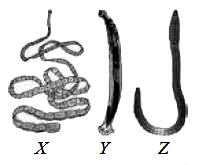Refer to the given diseases.
(i) Athlete's foot
(ii) Sleeping sickness
(iii) Hepatitis-B
(iv) Tuberculosis
(v) Malaria
(vi) Mumps
(vii) Pneumonia
(viii) Ringworm
(ix) Typhoid
(x) Tetanus
Select the option which correctly identifies bacterial diseases (P), viral diseases (Q), protozoan diseases (R) and fungal diseases (S).

The correct Answer is:C
Step by step video, text & image solution for Refer to the given diseases. (i) Athlete's foot (ii) Sleeping sickness (iii) Hepatitis-B (iv) Tuberculosis (v) Malaria (vi) Mumps (vii) Pneumonia (viii) Ringworm (ix) Typhoid (x) Tetanus Select the option which correctly identifies bacterial diseases (P), viral diseases (Q), protozoan diseases (R) and fungal diseases (S). by Biology experts to help you in doubts & scoring excellent marks in Class 8 exams.
Topper's Solved these Questions
- BOOK - SCIENCE OLYMPIAD FOUNDATION CHAPTER - MICROORGANISMSEXERCISE - ACHIEVERS SECTION (HOTS)5videos
MICROORGANISMS
- BOOK - SCIENCE OLYMPIAD FOUNDATION CHAPTER - CROP PRODUCTION AND MANAGEMENTEXERCISE - ACHIEVERS SECTION (HOTS)5videos
CROP PRODUCTION AND MANAGEMENT
- BOOK - SCIENCE OLYMPIAD FOUNDATION CHAPTER - NSO MODEL TEST PAPER -1EXERCISE - ACHIEVERS SECTION2videos
NSO MODEL TEST PAPER -1
Similar Questions
Name the vectors of following diseases :
(i) Kala azar (ii) Sleeping sickness (iii) Typhus (iv) Bubonic plague (v) Malaria (vi) Dengue.View SolutionName the deficiency diseases caused due to deftclency of
(i) Iodine (ii) Vitamin B2 (iii) Vitamin D (iv) Fluorine
(v) Vitamin C (vi) Vitamin A (vii) Vitamin B12 (viii) Iron.View Solution
Knowledge Check
- Question 1 - Select One
Slect the option that correctly fills up the blanks in the given paragraphs After one month of pregnancy the embryo's (i)._____is formed By the end of the (ii)._____month of pregnancy the fetus develops limbs and digits. By the end of (iii)._____most of the major organ systems are formed, for example, the limb and external genital organs are well-developed by the end of (iv)._____the body is covered with fine hair, eye-lids separate, and eyelashed are formed
Afront, rear, near, front, rearBfront, rear, front, rear, rearCrear, front, front, rear, frontDrear, front, rear, front, front - Question 2 - Select One
Which is common between AIDS and Hepatitis -B ?
(i) both are viral diseases
(ii) Both are transmitted by infected needles and syringes
(iii) Both are infectious diseases
(iv) Both are chronic diseases
(v) Both are ultimately fatalAii, iii, iv and vBI, ii, iii and vCI, ii, iii, iv and vDii, iii, and v - Question 3 - Select One
Increase in global temperature increases the incidence of which of the following infectious disease(s)?
(i) Sleeping sickness (ii) Yellow fever (iii) Malaria (iv) DengueA(ii) onlyB(i) and (ii)C(iii) and (iv)D(i), (ii), (iii) and (iv)
A few common substances are listed below.
(i) Air, (ii) Graphite, (iii) Gasoline, (iv) Diamond, (v) Tap water, (vi) Iron, (vii) Sodium chloride, (viii) lodised salt, (ix) Brass, (x) Oil and water
Which of the following represents the correct classification of the given substances ? View Solution
View SolutionWhich of the following are state functions?
(i) Q
(ii) w
(iii). Q+w
(iv) Q-w
(v) Qv
(vi) QpP
(vii) Qw
(viii). QT
(ix) ΔXT
(x) U+PV
(xi) U−PVView SolutionRefer to the given figures of different animals.
Read the characteristics given below and select the option that correctly matches these animals with their characteristics stated.

(i) Coelom absent
(ii) Pseudocoelom present
(iii) True coelom present
(iv) Triploblastic animal
(v) Flame cells as excretory organs
(vi) Body metamerically segmented
(vii) Nephridia are excretory organsView SolutionWhich of the following diseases are waterborne?
1. Typhoid 2. Hepatitis B
3. Tuberculosis 4. Hepatitis A
Select the correct answer using the code given belowView SolutionSickle cell anemia is an example of
(i) Menedelian disorder
(ii) Genetic disorder
(iii) Chromosomal disorder
(iv) Inborn error of metabolism
(v) Point mutation
(vi) Frame-Shift mutation
(vii) Sex-linked disease
(viii) Recessive disorder
(ix) Qualitative disorder
(x) Quantitative disorder
(xi) Autosomal disorderView Solution

